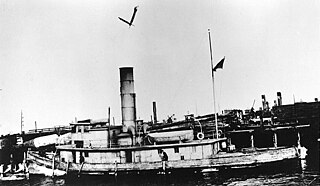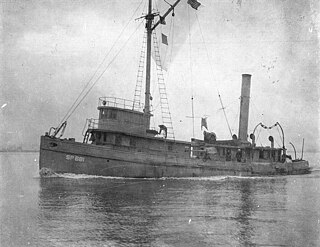
The second USS Conestoga (SP-1128/AT-54) was an ocean-going tug in the United States Navy. Commissioned in 1917, it disappeared in the Pacific Ocean in 1921. The fate of the vessel was a mystery until its wreck was positively identified in 2016.

USS Rail (AM-26/AT-139/ATO-139) was a Lapwing-class minesweeper built for the United States Navy during World War I. She was the first U.S. Navy ship named for the rail, a small wading bird, related to the cranes.

USS Owl (AM-2) was an Lapwing-class minesweeper acquired by the U.S. Navy for the dangerous task of removing mines from minefields laid in the water to prevent ships from passing.

USS Turkey (AM-13) was an Lapwing-class minesweeper acquired by the U.S. Navy for the dangerous task of removing mines from minefields laid in the water to prevent ships from passing.

The second USS Tern (AM-31) was an Lapwing-class minesweeper acquired by the U.S. Navy for the dangerous task of removing mines from minefields laid in the water to prevent ships from passing.

USS Vireo (AM-52) was a U.S. Navy Lapwing-class minesweeper, No. 52, reclassified on 1 June 1942 as a fleet tug. The bulk of her combat career was served in this capacity.

The third USS Ontario (AT–13), a single screw seagoing tug, was laid down by the New York Shipbuilding Company, Camden, New Jersey on 23 November 1911, launched on 11 April 1912, and commissioned at Philadelphia Navy Yard on 4 September 1912, Chief Boatswain S. M. McCarthy in command.

USS James (SP-429) — also known as USS W. T. James (SP-429) — was a steam trawler acquired by the United States Navy during World War I. She was converted into an armed minesweeper and assigned to the European Theater, where she performed varied tasks, including minesweeping, patrolling, and escorting of larger ships in convoy. In 1919, while returning to the United States, she was severely damaged in a storm off the French coast, and sank. Her crew were rescued.

USS Goliah (SP-1494), also listed as ID-1494, was an armed tug that served in the United States Navy as a patrol vessel and tug from 1918 to 1919.

The fourth USS Fulton (SP-247), later USS SP-247, was a commercial tug built in 1909. She was commissioned by the United States Navy and served as a minesweeper in 1917 in the Third Naval District and returned to her previous owners two years later. She remained in service, latterly as Catherine Carroll, at least into the 1960s.
USS Lowell (SP-504) was a United States Navy patrol vessel and minesweeper in commission from 1917 to 1919.

USS Navajo III (SP-298), later USS SP-298, was an armed motorboat that served in the United States Navy as a patrol vessel from 1917 to 1919.
USS Freehold (SP-347) was a minesweeper and tug that served in the United States Navy from 1917 to 1919.

USS Charles P. Crawford (SP-366) was a United States Navy minesweeper and tug in commission from 1917 to 1919.

USS Knickerbocker (SP-479), was a United States Navy tug, minesweeper, and dispatch ship in commission from 1917 to 1919.

USS Dreadnaught (ID-1951), later YT-534 and YNG-21, was a United States Navy tug that was in service from 1918 to 1944.

USS Breakwater (SP-681) was a United States Navy patrol vessel, minesweeper, and tug in commission from 1917 to 1920.

The first USS Menhaden (SP-847) was a United States Navy patrol vessel and tug in commission from 1917 to 1919.

The tugboat is a New York City icon. Once all steam powered, they soon became iconic, starting with the first hull, the paddler tug Rufus W. King of 1828.

USS Arctic (SP-1158) was a wooden-hulled steam tug acquired by the US Navy during World War I. Arctic was briefly employed as a convoy escort during the war and later used to tow targets and transport ammunition. She was returned to commercial service in 1919.

















